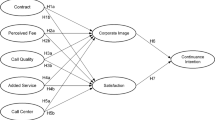Abstract
Generating sustainable business value from information services is challenging on the web where free information and zero-switching costs are the norm. This study examines the role of free comments given in a commercial information service through the lens of the expectation-confirmation theory and continuance. Data from a question and answer web site are analyzed by structural equations modeling to test the theoretical model whereby customer satisfaction is key to continuance and is predicted largely by social interaction that takes place on the site. The model is supported by the field data retrieved from the site. The data show that people came with equal expectations, received equal service, and continued to use the system if they were satisfied with it. Satisfaction was predicted by conversation. Free activity emerges as an integral part of the service in a fee-based information market, improving satisfaction and continuance, and thereby leading to measurable outcomes for the commercial owners of the site. The findings, based on unobtrusive field data rather than self-report questionnaires, extend expectation confirmation theory by adding a social dimension to it.



Similar content being viewed by others
References
Adamic LA, Zhang J, Bakshy E and Ackerman MS (2008) Knowledge sharing and yahoo answers: everyone knows something. Proceeding of the 17th International Conference on World Wide Web, Beijing, China, pp 665–674.
Anderson C (2009) Free! Why $0.00 is the Future of Business. Hyperion, New York.
Anderson RE (1973) Consumer dissatisfaction: the effect of disconfirmed expectancy on perceived product performance. Journal of Marketing Research 10 (1), 38–44.
Bhattacherjee A (2001a) An empirical analysis of the antecedents of electronic commerce service continuance. Decision Support Systems 32 (2), 201–214.
Bhattacherjee A (2001b) Understanding information systems continuance: an expectation-confirmation model. MIS Quarterly 25 (3), 351–370.
Carmon Z, Shanthikumar JG and Carmon TF (1995) A psychological perspective on service segmentation models: the significance of accounting for consumers’ perceptions of waiting and service. Management Science 41 (11), 1806–1811.
Chiu CM, Hsu MH, Sun SY, Lin TC and Sun PC (2005) Usability, quality, value and e-learning continuance decisions. Computers & Education 45 (4), 399–416.
Cohen J (1992) A power primer. Psychological Bulletin 112 (1), 155–159.
Connolly T and Thorn BK (1990) Discretionary databases: theory, data, and implications. In Organizations and Communication Technology (Fulk J and Steinfield CW, Eds), pp 219–233, Sage Publications, Newbury Park.
Davis FD, Bagozzi RP and Warshaw PR (1989) User acceptance of computer technology: a comparison of two theoretical models. Management Science 35 (8), 982–1003.
Delone WH and McLean ER (2003) The DeLone and McLean model of information systems success: a ten-year update. Journal of Management Information Systems 19 (4), 9–30.
Edelman B (2004) Earnings and ratings at Google answers. Unpublished manuscript.
Harper MF, Raban DR, Rafaeli S and Konstan J (2008) Predictors of answer quality in online Q&A sites. In Twenty-sixth Annual SIGCHI Conference on Human Factors in Computing Systems, pp 865–874, Florence, Italy.
Hsieh G, Kraut RE and Hudson SE (2010) Why pay?: exploring how financial incentives are used for question & answer. Proceedings of the 28th International Conference on Human Factors in Computing Systems, Atlanta, GA, pp 305–314.
Jiang Z, Wang W and Benbasat I (2005) Multimedia-based interactive advising technology for online consumer decision support. Communications of the ACM 48 (9), 93–98.
Kumar N and Benbasat I (2002) Para-social presence: a reconceptualization of ‘social presence’ to capture the relationship between a web site and her visitors. Proceedings of the 35th Hawaii International Conference on System Sciences. Computer Science Press, Washington DC.
Mittal V and Kamakura WA (2001) Satisfaction, repurchase intent, and repurchase behavior: investigating the moderating effect of customer characteristics. Journal of Marketing Research 38 (1), 131–142.
Oliver RL (1980) A cognitive model of the antecedents and consequences of satisfaction. Journal of Marketing Research 17 (4), 460–469.
Ong C, Day M and Hsu W (2009) The measurement of user satisfaction with question answering systems. Information & Management 46 (7), 397–403.
Patterson PG, Johnson LW and Spreng RA (1997) Modeling the determinants of customer satisfaction for business-to-business professional services. Journal of the Academy of Marketing Science 25 (1), 4–17.
Qureshi I, Fang Y, Ramsey E, McCole P, Ibbotson P and Compeau D (2009) Understanding online customer repurchasing intention and the mediating role of trust an empirical investigation in two developed countries. European Journal of Information Systems 18 (3), 205–222.
Raban DR (2007) User-centered evaluation of information: a research challenge. Internet Research 17 (3), 306–322.
Raban DR (2008a) The incentive structure in an online information market. Journal of the American Society for Information Science and Technology 59 (14), 2284–2295.
Raban DR (2008b) The incentive structure in an online information market. Journal of the American Society for Information Science and Technology 59 (14), 2284–2295.
Raban DR (2009) Self-presentation and the value of information in Q&A web sites. Journal of the American Society for Information Science and Technology 60 (12), 2465–2473.
Raban DR and Rabin E (2009) Statistical inference from power law distributed web-based social interactions. Internet Research 19 (3), 266–278.
Rafaeli S and Noy A (2005) Social presence: influence on bidders in internet auctions. EM – Electronic Markets 15 (2), 158–176.
Rafaeli S and Raban DR (2005) Information sharing online: a research challenge. International Journal of Knowledge and Learning 1 (1/2), 62–79.
Regner T (2005) Why voluntary contributions? Google answers!. CMPO Working Paper Series, Working Paper No. 05/115.
Resnick P, Kuwabara K, Zeckhauser R and Friedman E (2000) Reputation systems. Communications of the ACM 43 (12), 45–48.
Resnick P, Zeckhauser R, Swanson J and Lockwood K (2006) The value of reputation on eBay: a controlled experiment. Experimental Economics 9 (2), 79–101.
Shapiro C and Varian HR (1999) Information Rules: A Strategic Guide to the Network Economy. Harvard Business School Press, Boston.
Taylor S and Todd PA (1995) Understanding information technology usage: a test of competing models. Information Systems Research 6, 144–176.
Van Alstyne MW (1999) A proposal for valuing information and instrumental goods. Proceedings of the 20th International Conference on Information Systems, pp 328–345, Charlotte, North Carolina.
Wixom BH and Todd PA (2005) A theoretical integration of user satisfaction and technology acceptance. Information Systems Research 16 (1), 85.
Acknowledgements
This research has been supported by a grant from the Israel Foundations Trustees (2006–2008).
Author information
Authors and Affiliations
Corresponding author
Rights and permissions
About this article
Cite this article
Ruth, R. Conversation as a source of satisfaction and continuance in a question-and-answer site. Eur J Inf Syst 21, 427–437 (2012). https://doi.org/10.1057/ejis.2011.42
Received:
Revised:
Accepted:
Published:
Issue Date:
DOI: https://doi.org/10.1057/ejis.2011.42




